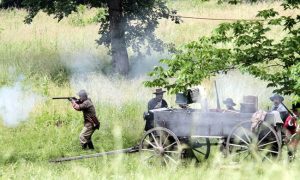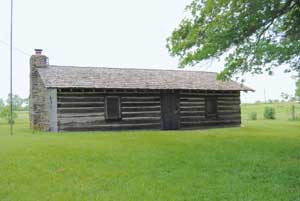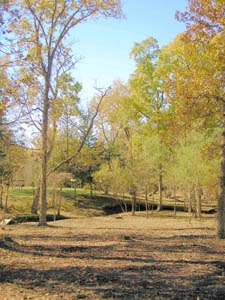Black Jack, Kansas – Legends of Kansas (original) (raw)
Black Jack, Kansas Historical Markers by Kathy Alexander.
Black Jack, Kansas, located in Douglas County, was established in 1855 along the Santa Fe Trail as a supply point for traders and pioneers.
The creek near the village was named Black Jack by Mexicans traveling along the trail, and the village was named after the creek. Some of its first settlers to the community were William Riley, David Fearer, E. D. Pettengill, S.A. Stonebraker, and H. N. Brockway.
A re-creation of the Battle of Black Jack. Photo courtesy Baldwin City Signal.
The town had barely been settled before it found itself amid the Kansas-Missouri Border War. After abolitionist John Brown’s two sons were captured and held prisoner by Henry Pate, Brown and 29 men fought the Battle of Black Jack on June 2, 1856, against Pate and his men. John Brown and his men won the battle, capturing 22 of their opponents, which Brown agreed to release when his sons were released. Some historians consider the Battle of Balck Jack the first actual battle of the Civil War.
Also killed in June of that year was one of the first setters — David Fearer, a Corporal in Company D of the 2nd Missouri Militia. William Quantrilll’s guerillas shot him down in an ambush between Independence and Pleasant Hill, Missouri, while on patrol guarding a mail coach. They also broke into and robbed Brockway & Stonebraker’s store, carrying away about $1,800 worth of goods and setting fire to the building. The fire was extinguished by a determined lady named Mrs. John M. Hays.
An old cabin is preserved at Black Jack, Kansas, by Kathy Alexander.
The town was incorporated in 1857, and the first school was held in a log house, taught by Mrs. Elizabeth Craig, in 1858. The first sermon was also preached in a cabin by Reverend Samuel Kretsinger the same year. The post office was established on March 15, 1858, with S.A. Stonebraker appointed the first postmaster who had started the first store in January. A schoolhouse and the Presbyterian Church were both built in 1859. It boasted a tavern, post office, blacksmiths, a hotel, a general store, a doctor’s office, schools, and two churches at its peak.
During the Civil War, a fort was erected here to protect the town. On May 8, 1863, Dick Yeager raided the village, robbed Brockway & Stonebraker’s store, and stole the horses on the overland stage route. On August 15 of the same year, “Bloody Bill” Anderson made a raid into Kansas, and on his return from Morris County, where he had killed Captain Baker, thrown his body into the cellar, and burned his house down over him, made a call on Black Jack. He intercepted the overland mail, stole 14 horses, eight belonging to the mail, and took some $2,000 from the passengers.
Battle of Black Jack, Kansas site by Kathy Alexander.
After the Civil War, traffic along the Santa Fe Trail began to dwindle, especially after the completion of the Kansas Pacific Railroad to Ellsworth. The post office was closed on October 20, 1894, and the town was soon abandoned.
The site is located near U.S. Highway 56, about three miles east of Baldwin City, with interpretive signs pointing out where the battle started and ended. The old townsite is partially within Robert Hall Pearson Memorial Park. Located adjacent to and immediately south of the Black Jack Highway Park, the Ivan Boyd Prairie Preserve contains some of the best-preserved and managed native prairie in Douglas County, Kansas. The site is well known for containing evidence of the wagon ruts caused by travel along the Santa Fe Trail.
©Kathy Alexander/Legends of Kansas, updated August 2024.
Also See:



